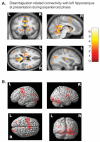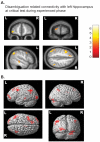The hippocampus is functionally connected to the striatum and orbitofrontal cortex during context dependent decision making
- PMID: 22000080
- PMCID: PMC3205300
- DOI: 10.1016/j.brainres.2011.09.038
The hippocampus is functionally connected to the striatum and orbitofrontal cortex during context dependent decision making
Abstract
Many of our everyday actions are only appropriate in certain situations and selecting the appropriate behavior requires that we use current context and previous experience to guide our decisions. The current study examined hippocampal functional connectivity with prefrontal and striatal regions during a task that required participants to make decisions based on the contextual retrieval of overlapping sequential representations. Participants learned four sequences comprised of six faces each. An overlapping condition was created by having two sequences with two identical faces as the middle images. A non-overlapping condition contained two sequences that did not share any faces between them. Hippocampal functional connectivity was assessed during the presentation period and at the critical choice, where participants had to make a contextually dependent decision. The left hippocampus showed significantly increased functional connectivity with dorsal and ventral striatum and anterior cingulate cortex during the presentation period of the overlapping compared to the non-overlapping condition after participants knew the sequences. At the critical choice point of the overlapping condition, the left hippocampus showed stronger functional connectivity with the orbitofrontal cortex. These functional connectivity results suggest that the hippocampus may play a role in decision making by predicting the possibilities of what might come next, allowing orbitofrontal and striatal regions to evaluate the expected choice options in order to make the correct action at the choice point.
Copyright © 2011 Elsevier B.V. All rights reserved.
Figures






Similar articles
-
Role of the hippocampus and orbitofrontal cortex during the disambiguation of social cues in working memory.Cogn Affect Behav Neurosci. 2013 Dec;13(4):900-15. doi: 10.3758/s13415-013-0170-x. Cogn Affect Behav Neurosci. 2013. PMID: 23640112 Free PMC article.
-
Dorsal striatal-midbrain connectivity in humans predicts how reinforcements are used to guide decisions.J Cogn Neurosci. 2009 Jul;21(7):1332-45. doi: 10.1162/jocn.2009.21092. J Cogn Neurosci. 2009. PMID: 18752410
-
Cooperative interactions between hippocampal and striatal systems support flexible navigation.Neuroimage. 2012 Apr 2;60(2):1316-30. doi: 10.1016/j.neuroimage.2012.01.046. Epub 2012 Jan 14. Neuroimage. 2012. PMID: 22266411 Free PMC article.
-
Integrating hippocampus and striatum in decision-making.Curr Opin Neurobiol. 2007 Dec;17(6):692-7. doi: 10.1016/j.conb.2008.01.003. Epub 2008 Mar 4. Curr Opin Neurobiol. 2007. PMID: 18313289 Free PMC article. Review.
-
Corticostriatal Interactions during Learning, Memory Processing, and Decision Making.J Neurosci. 2009 Oct 14;29(41):12831-8. doi: 10.1523/JNEUROSCI.3177-09.2009. J Neurosci. 2009. PMID: 19828796 Free PMC article. Review.
Cited by
-
Noninvasive functional and anatomical imaging of the human medial temporal lobe.Cold Spring Harb Perspect Biol. 2015 Mar 16;7(4):a021840. doi: 10.1101/cshperspect.a021840. Cold Spring Harb Perspect Biol. 2015. PMID: 25780085 Free PMC article. Review.
-
Self-regulation training generalizability using the regulation of craving task. An fMRI study.Front Psychol. 2024 Jul 23;15:1399456. doi: 10.3389/fpsyg.2024.1399456. eCollection 2024. Front Psychol. 2024. PMID: 39108432 Free PMC article.
-
Striatum on the anxiety map: Small detours into adolescence.Brain Res. 2017 Jan 1;1654(Pt B):177-184. doi: 10.1016/j.brainres.2016.06.006. Epub 2016 Jun 6. Brain Res. 2017. PMID: 27276526 Free PMC article. Review.
-
Adolescent substance use and functional connectivity between the ventral striatum and hippocampus.Behav Brain Res. 2020 Jul 15;390:112678. doi: 10.1016/j.bbr.2020.112678. Epub 2020 May 13. Behav Brain Res. 2020. PMID: 32413469 Free PMC article.
-
Hippocampal and ventral medial prefrontal activation during retrieval-mediated learning supports novel inference.Neuron. 2012 Jul 12;75(1):168-79. doi: 10.1016/j.neuron.2012.05.010. Neuron. 2012. PMID: 22794270 Free PMC article. Clinical Trial.
References
-
- Addis DR, Pan L, Vu MA, Laiser N, Schacter DL. Constructive episodic simulation of the future and the past: distinct subsystems of a core brain network mediate imagining and remembering. Neuropsychologia. 2009;47(11):2222–2238. - PubMed
-
- Alexander GE, DeLong MR, Strick PL. Parallel organization of functionally segregated circuits linking basal ganglia and cortex. Annu Rev Neurosci. 1986;9:357–381. - PubMed
Publication types
MeSH terms
Substances
Grants and funding
LinkOut - more resources
Full Text Sources

